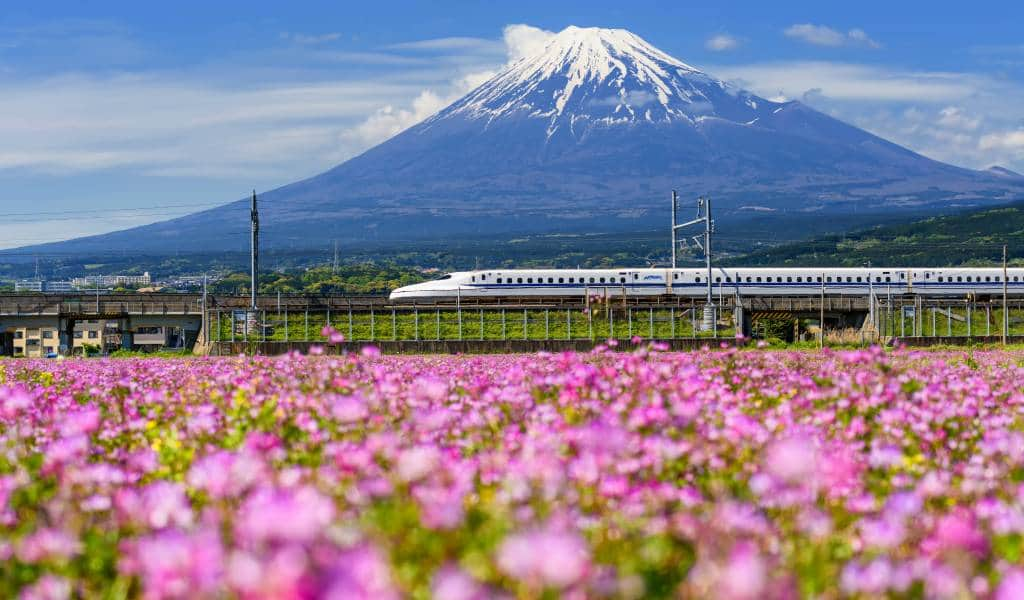Thinking of shelling out for the JR Pass and want to make sure you get your money’s worth? We have the perfect 7-day Japan itinerary for you—taking you all over the main island and back to Tokyo!
Those JR passes seem like a lot, but if you plan your trip right, you’ll soon be sitting back, relaxing and earning that money back in luxury. If you’re only planning to go to Kyoto and back, it may seem like a push, but if you’re going to shell out for the pass, you may as well stretch it out.
Giving yourself a few days in Tokyo before starting the pass and you can have a 10-day break and still see plenty of the country, hitting all the major stops and ticking off those bucket-list sights. This is not a tour for those who like a lie-in though, with lots of travel and plenty of early starts, you’ll be pretty tired by the end of it. A week is a long time though, and if it’s all you’ve got in Japan, then why not make it count?
The route
Tokyo | Sendai | Kanazawa | Shirakawago | Kyoto | Nara | Osaka | Hiroshima | Fukuoka | Tokyo
You’ll recognize a few, if not all of the names on our list and if you care to look at a map, you’ll see we’re covering some real distance (just over 3000 km if you really want to know). All of that means you will be spending a good chunk of time on trains—but treat this as planning time, nap time or just reading a book time—whatever helps you get through it. One thing that will help is that bullet trains are kind of amazing—with comfy seats, folding tables, leg room and great views, you can at least travel in comfort. Take food and drinks as you are allowed to eat on these, and settle in for the ride. The only long journey will be your return one, clocking in at 6 hours, but you’ll more than likely be snoozing away by then so I wouldn’t worry too much! We have tried to cover as much of Japan as possible, but sadly Hokkaido, Shikoku and Okinawa just didn’t make it in, but that’s all the more reason to come back again soon!
The savings (and the costs)
If we add up every route as it would cost on a regular bullet train with no JR Pass, the grand total would be an eye-watering ¥72,480. Compared to your pass which costs only ¥29,110—that’s a massive saving of over ¥40,000, which can buy you a hell of a lot of sushi.
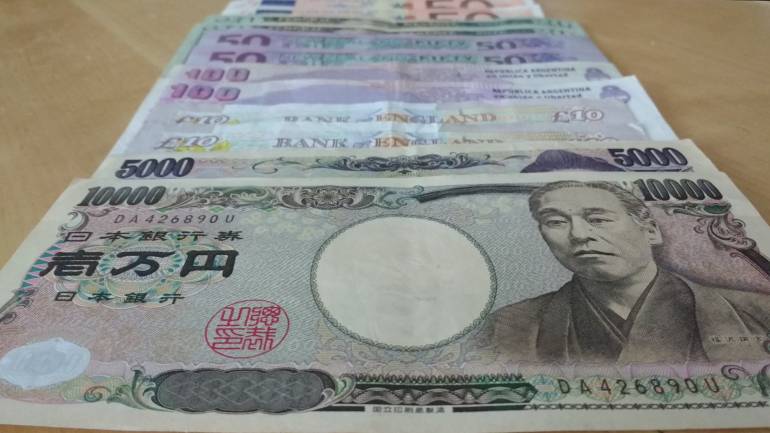
There are a few smaller transport costs in the journey that aren’t covered by the JR Pass though, so if you’re short on cash you can switch the options out for something else, or just tack them on. Also, aside from the stations listed below, depending on where you stay in cities like Osaka, you may have to catch a subway to the closest stations for the bullet train—so keep that in mind too. NOTE: In the Japan itinerary all amounts listed like this [500 yen] are covered by the JR Pass and those un-italicized, without box brackets like this: 500 yen, are not. The total does not include the optional side trips like Zao Fox Village, for example.
- Bus from Kanazawa to Shirakawago and back: 3,700 yen
- Bus and train in Kyoto: 880 yen
- Trams in Hiroshima: 360 yen
- Total: 4,940 yen
The tips
A trip like this requires schedules and planning, not a laissez-faire attitude to train times and meanderings that lead you miles from the station, so we have some tips to make sure it runs smoothly!
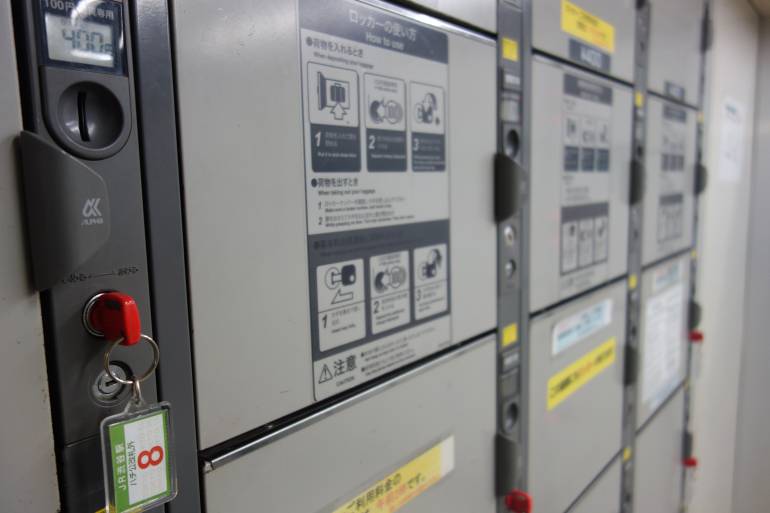
- Reserve your bullet train tickets in advance—either all at once, or a journey or two ahead. Trains get full in peak season and during commuting hours. Although there are often plenty of seats and an unreserved car, it’s free, gives you a time frame to aim for and guaranteed seats together if in a couple or group.
- Consider sitting separately if in a group—if there are no seats available together, try single seats as you have a much better chance. Alternatively just try the unreserved carriage for available seats.
- Store luggage in train station lockers when you can, as there’s a lot of walking and city-hopping, often returning to the same station—for example in Kanazawa, Nara and Hiroshima.
- Keep some water, snacks and onigiri in your bag—with so much sightseeing to do you’ll work up an appetite!
Day 1 – Sendai – Stay Overnight
8am start | Bullet train from Tokyo Station to Sendai | Direct | 92 minutes | [11,000 yen]
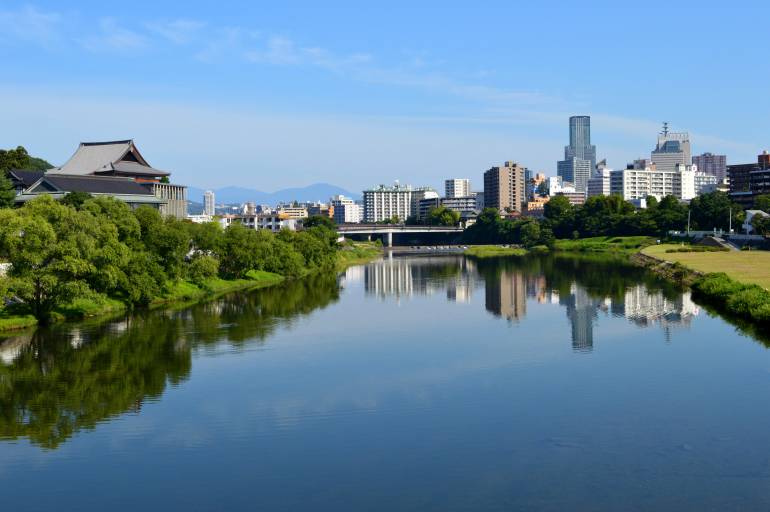
Leaving Tokyo at 8am you can arrive in Sendai in time to grab a coffee and start exploring the Sendai no Dokoro—the local market (also called Sendai Asaichi), which is open from morning until mid-afternoon—near the west exit of the station. The name means “Sendai’s kitchen,” and you’ll easily see why. This is the farthest north of Tokyo your trip will take you, so take a chance to enjoy the fresh mountain air and cooler weather.
Sendai is famous for beef tongue and the city’s Tanabata Festival in August, with amazing decorations and performances. The Zuihoden Mausoleum is a stunning building decorated with complex woodwork and and vivid colors. You can access it via the Sendai Loop Bus, getting off at bus stop four. There are temples and shrines in the city as well as castle ruins and a city museum, so plenty to keep you occupied.
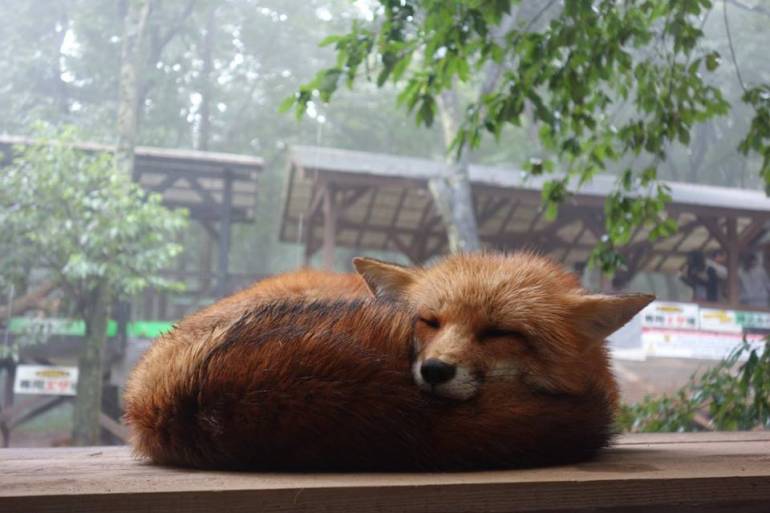
You could also visit the Zao Fox Village—a mountainside park where foxes live in the wild, but close enough to be seen and fed—with some cubs able to be held in spring. A popular day trip from Tokyo, you can catch the Shinkansen Yamabiko from Tokyo to Shiroishizao Station and then get a taxi to the village (or the rare bus). You are only 15 minutes from Sendai on the same train line, so you can head back over to the main city after your trip in time for a beef-tongue dinner.
Day 2 – Kanazawa – Stay Overnight
8:16am start | Bullet train from Sendai to Kanazawa | One transfer | 3 hours, 22 mins | [21,700 yen]
Wake up in time to catch the 8:16am Shinkansen Komachi to Omiya, and jump on the Kagayaki to arrive in Kanazawa just before noon. You can explore the Omicho Market near the train station for fresh veg, street snacks and souvenirs before heading to see the most beautiful garden in all of Japan, Kenrokuen. With a dedicated shuttle bus from the station or 1-3 JR buses an hour (East Exit bus stop 4) you can save the 200-yen fare if you’re lucky with the times.
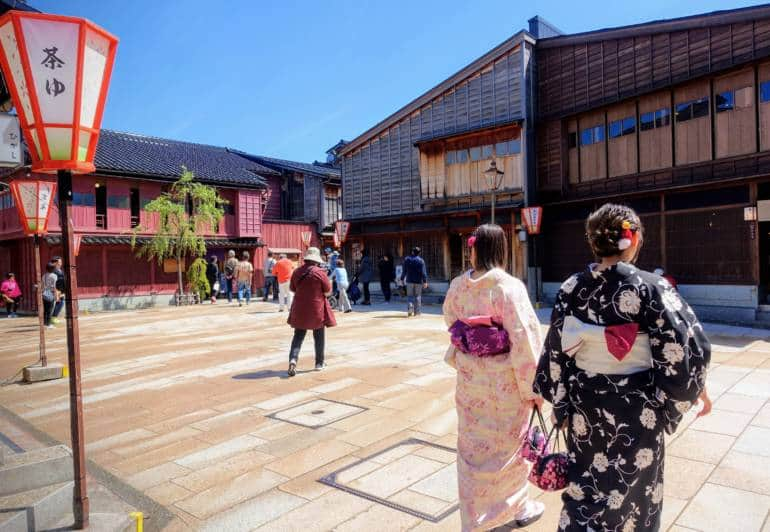
Afterwards, hop onto the Loop bus and visit Higashi Chaya District with tea houses once frequented by geisha and now open to the public. If you visit Kaikaro tea house, entry of ¥750 includes tea service, and the nearby Shima tea house has been converted into a museum. Don’t miss the Hakuza gold leaf store; Kanazawa produces 99% of domestic gold leaf, with production dating as far back as the 16th century. The store has a warehouse converted into a completely golden tea room, as well as souvenirs with gold leaf.
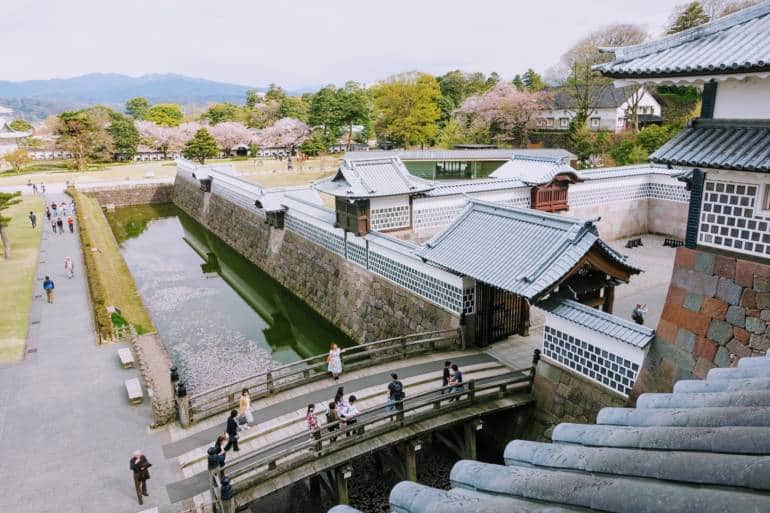
If you still have time, head to Ninjadera, a temple with deceptive defenses built for the Maeda Lords in the Edo period. With hidden tunnels, secret doors and staircases, traps and more, the guided tour shows them all. If you don’t have time for both, there is a small Geisha area called Nishi Chaya dictrict closer to the temple. Stay overnight in Kanazawa, stroll through the older areas in the evening to enjoy the ambience.
Day 3 – Shirakawago | Travel to Kyoto – Stay Overnight
8:10am start | Highway bus to Shirakawago | Direct | 75 minutes | 3,700 yen round trip
Catch the 8:50am bus to Shirakawago from the East gate of Kanazawa train station (requires a reservation which can be made here) and arrive bright and early at 9:25am. Famed for their picturesque tilted roofs, the houses of Shirakawago are often photographed buried in snow but are equally picturesque in spring and autumn especially. The Gassho-zukuri farmhouses are up to 250 years old and the names translates as “constructed like hands in prayer”—allowing them to withstand the growing weight of snow in winter.
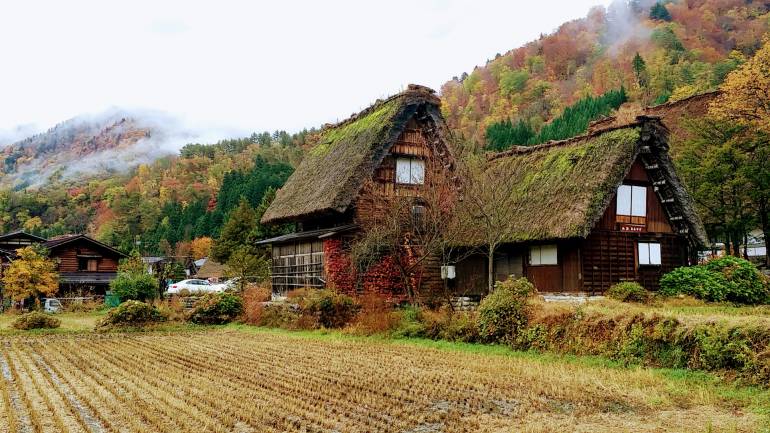
The main town of Ogimachi is beautiful to stroll through (if you ignore the occasional washing machine and concrete visitor center) especially when seen from the Shiroyama viewpoint. During the winter, illuminations light the town on certain nights, giving a magical feel to the village. There is an open-air museum across the river with relocated houses, moved to prevent their destruction. Dotted around the village are especially well preserved houses such as the Kanda-ke house and the Myozenji Temple and house, as well as the Doburoku Festival Museum where you can try the locally produced sake and the onsen at Shirakawago-n0-yu.
Unfortunately, none of the buses are covered by the JR Pass so you will have to shell out for this journey, but this is the biggest spend on travel, so don’t worry—it is the exception! Hop back on a bus to Kanazawa at 3:20pm, arriving back at 4:45pm in time to grab some food and stretch your legs before the next part of the journey!
17:30 Start | Limited express train to Kyoto | Direct | 2 hours | [6,700 yen]
Next, hop on the 17:33 Thunderbird limited express to Kyoto. After a nap, you’ll get in at 19:38 and can head to your hostel. If you have the energy, this is a great time to go for a wander beside the Kamo River, with the famous Pontocho restaurant street and the more affordable street running along the narrow river parallel to the Kamo.
Day 4 – Kyoto | Stay Overnight
8am start | Bus and metro inner-city travel | 880 yen
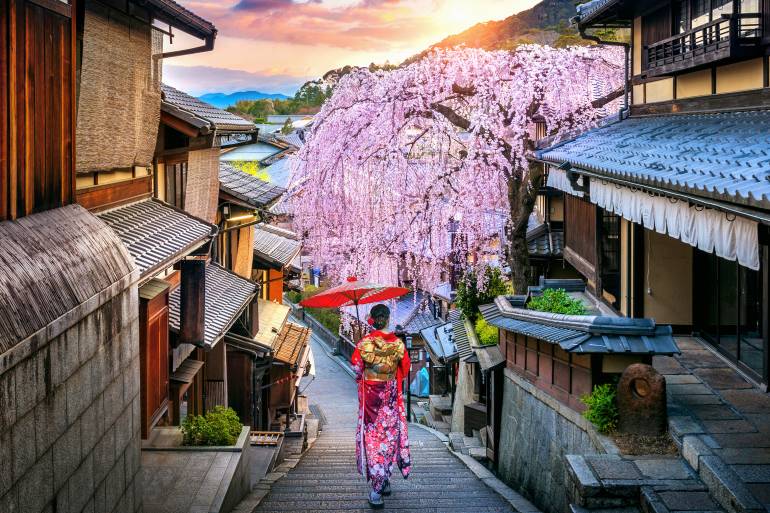
The most visited spot after Tokyo, Kyoto has an incredible amount of things to see – so have a look at our 2-day guide to choose which you like best. For a suggested day’s worth, though, make sure you’ve got your walking shoes on and some change for the bus! Head to the train station bus stops at around 8am and hop onto one of the frequent buses (try Raku 101 or 1o2, but there are a few) that head to Kinkakuji Temple and settle in. Getting a seat is a great win, as you’re on the bus for around 45 minutes. Buses are a flat rate of 230 yen so you won’t need that 500-yen day bus pass as we are only making this return journey. You should arrive just as it opens and can enjoy a (relatively) quiet walk through the grounds. When done, take a bus back to town, but alight at Shijo-dori, the main shopping street. Here you can walk up to Nishiki Market, then on to Yasaka Shrine. After that it’s a pretty simple route down through Higashiyama to Kiyomizudera before you hop onto a train at Kiyomizu-gojo for Fushimi Inari and the thousand red torii gates.

This is a busy day, so keep an eye on the time, because although Fushimi doesn’t close, the food stalls and gift shops do at around 5pm, so you may want to make it there just before that. The metro ticket will be 210 yen each way, on the way home jump off at Gion Shijo to explore the riverside area or explore Gion, depending on how much ground you covered yesterday evening and enjoy dinner at one of the local restaurants before turning in for the night.
Day 5 – Nara | Travel to Osaka – Stay Overnight
8:30am start | Train to Nara | Direct | 46 Minutes | [710 yen]
Nara is a fantastic day trip just outside of Kyoto, with stunning temples, great views and of course, ravenous deer. You can catch the JR train in the morning, ideally around 9am to arrive just before 10am and start your explorations. If you walk up towards Kofukuji you will be greeted by a temple complex as old as the establishment of the capital itself. Originally comprised of over 150 buildings, now only a few remain, but they are perfectly maintained and stunning to boot. The pagoda, Eastern Golden Hall and Southern Octagonal Hall are all impressive, although the Central Golden Hall is being reconstructed to its original design and will not be completed until 2018.
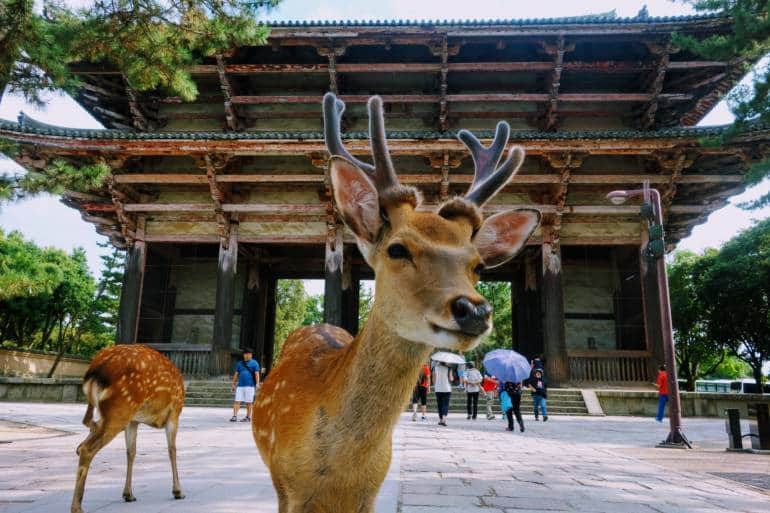
After this, continue on to the Nara Deer Park and buy some senbei (traditional crackers), but watch out for bags and sleeves which could be targeted by the deer—shameless is not the word. They will, however, bow for you in return for a snack which is pretty cute, and there are plenty of deer selfie (dare we say, delfie) opportunities too. Head up towards Todaiji, enjoying any street snacks on the way and stepping through Nandaimon, the 800-year-old wooden entrance gate to the temple. Inside, you’ll find the largest wooden structure in the world: the Great Buddha Hall, and within that, the world’s largest bronze statue of the Buddha Vairocana.
Afterwards, continue behind the hall towards the Tamukeyama Hachimangu Shrine, a balcony-style Shinto shrine established in the year 749 with stunning views of Nara and the tips of Todaiji’s roof. There are plenty of smaller shrines and temples around, so wander to your hearts content before heading back to the train station around mid-afternoon.
3:30pm start | Train to Osaka | Direct | 1 hour | [800 yen]
This evening you’ll be spending the night in Japan’s Kitchen: Osaka. With more culinary treats and neon lights than you can shake a stick out, this is the perfect city for an evening adventure. For the perfect Japanese experience, we suggest trying out a capsule hotel. The Asahi Plaza is only 5 minutes from Dotonbori, in a busy area and has a women’s floor (surprisingly uncommon), which means everyone can stay. If you do, the catch the JR line to JR Namba Station and walk up to the hotel from there—otherwise head to your hotel, drop your stuff and head out to explore after that!
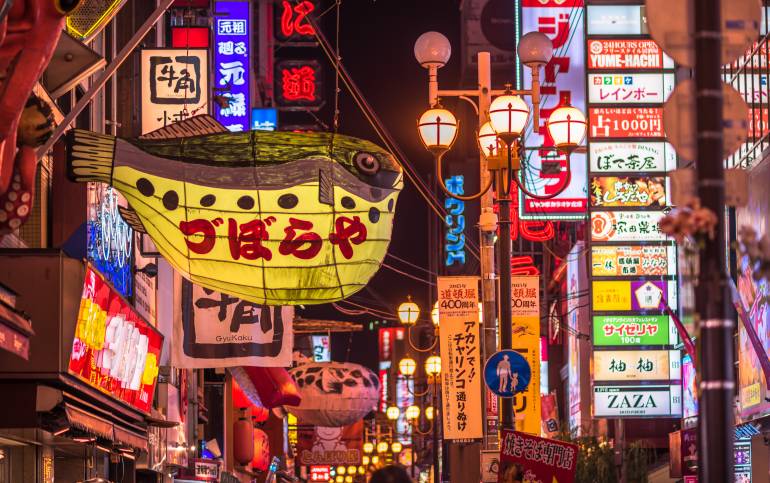
Dotonbori is the entertainment district of Osaka, with plenty to see and plenty you can’t ignore. The river’s neon lights and the over-sized food signs are an eye-catching combination tempting you towards a myriad of treats. Whether your try the roadside ramen, freshly flipped takoyaki or made-to-order okonomiyaki, you can’t go wrong. There’s the specialty of kushikatsu—various food deep-fried and dipped in a special sauce, as well as a market full of treats only a few minutes away. Make the most of you evening, feasting and strolling until you can feast and stroll no more, before crawling into your capsule for a hard-earned rest!
Day 6 – Hiroshima, Miyajima | Travel to Fukuoka – Stay Overnight
7:30am start | Train to Hiroshima, city tram | Direct | 1 hour 30 minutes | [10,030 yen] + 180 yen
Catch the Shinkansen Sakura from Shin-Osaka and head towards Hiroshima, a city famous worldwide. Starting your day off in Hiroshima is going to be emotionally difficult, to say the least—but it’s a vital part of the city’s history, and an incredible museum. Catch the Number 1 Orange Line Streetcar to Fukuro Machi (flat fare 180 yen not covered by the rail pass) for 15 minutes and walk over to the museum.
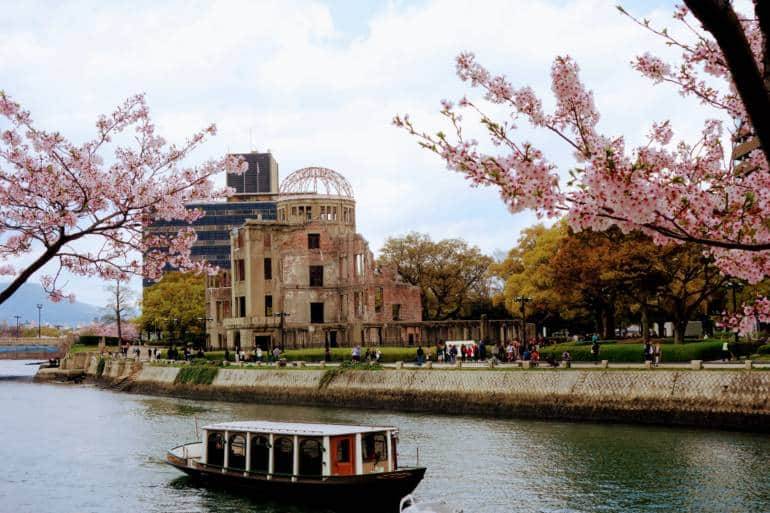
The Peace Memorial Museum has a range of displays documenting life before, the nightmare of, and after the atomic bomb dropped in 1945. Best earlier in the morning when less crowded, the museum provides a rounded and optimistic look at the future. Afterwards, you can take a walk through the Peace Park and see the A-bomb Dome, allowing the beauty of the park to slowly bring you back to a holiday mentality (for the most part).
12:30pm start | Tram, train, ferry to Miyajima | 1 hour | [590 yen] + 180 yen
To get to Miyajima there are boats from the river nearby, costing 2,000 yen one way and taking 45 minutes, which is great time-wise, but depends on your budget. Alternatively, you can catch the streetcar 15 minutes back to the station and catch the JR Sanyo line to Miyajimaguchi Station (30 minutes) where you can catch the 10-minute JR ferry to the island.
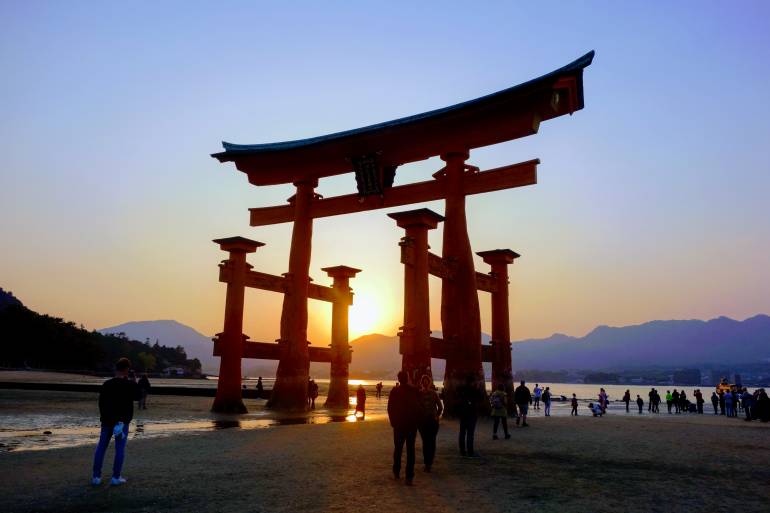
Once in Miyajima you can enjoy the incredible island and all it has to offer, from cute shopping streets, delicious treats and mountain hikes, as well as the world-famous shrine of course. The Itsukushima Shrine has a floating torii gate, probably on the cover of your guidebook, and you should be able to see it both at high (ish) and low tide, so you can walk up to it as well. Have a read of our full guide on all the things to do in Miyajima. There is plenty so we recommend getting there as close to lunch time as you can.
Catch the ferry back at around 6pm (so you can hopefully see the sunset!) and hop on a train back to Hiroshima Station where you can grab your luggage and get snacks for the train ahead.
7pm start | Train to Fukuoka | Direct | 1 hour 5 minutes | [9,060 yen]
Catch the bullet train to Fukuoka (Hakata Station) and make sure you get the Sakura and not the Kodama train which takes an extra 30 minutes (unless you are now enjoying your train time that much!). Once you arrive in Fukuoka, drop your stuff off at your hostel and head out to the river and Nakasu Island where you’ll find the city’s famous night stalls.
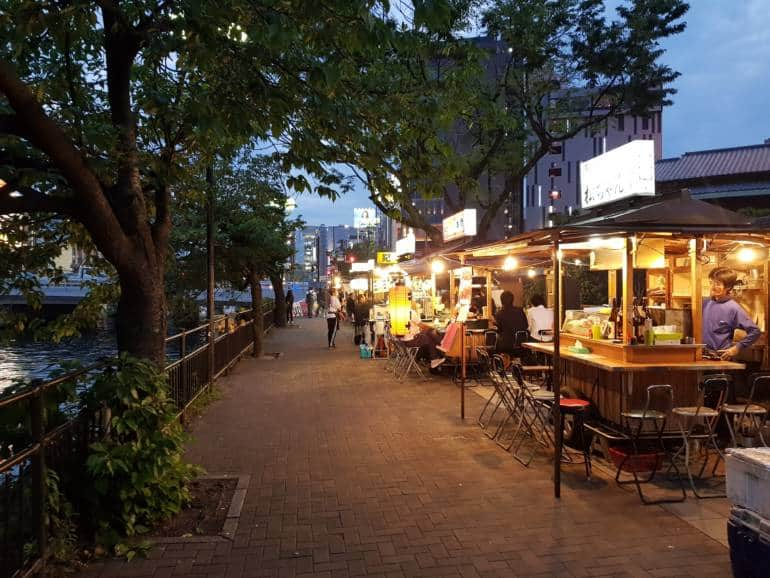
They’ll be open late selling the local specialty of Hakata ramen as well as drinks and chicken skewers. Enjoy your wanderings and turn in for the night!
Day 7: Day in Fukuoka | Return to Tokyo
Fukuoka doesn’t usually make the cut for travelers on a tight time budget, but it is a large city with plenty of great towns nearby for side trips. In the city itself, you can head to Yanagibashi Market. The biggest shopping center, Canal City ,is a sight to behold—with lit canals, shops, restaurants, as well as daily shows and performances. It is also home to Ramen Stadium, offering ramen from not only Hakata, but all over Japan. Enjoy the seasonal flowers in Nokoshima Park or take a break in Ohori Park, visit Tochoji, the first temple built by Kukai in Japan—the list is endless, and yours for the making.

As far as day trips are concerned, Yanagawa is an excellent one: an old castle town renowned for its relaxing boat rides along the river to the sea of Ariake will take you back to ancient Japan. With your boatman describing local points of interest (albeit in Japanese) you can imagine days gone by, and even join a clam digging boat tour from spring to autumn, if reserved in advance. Known as the Venice of Japan, you can’t go wrong on a sunny day in a boat.
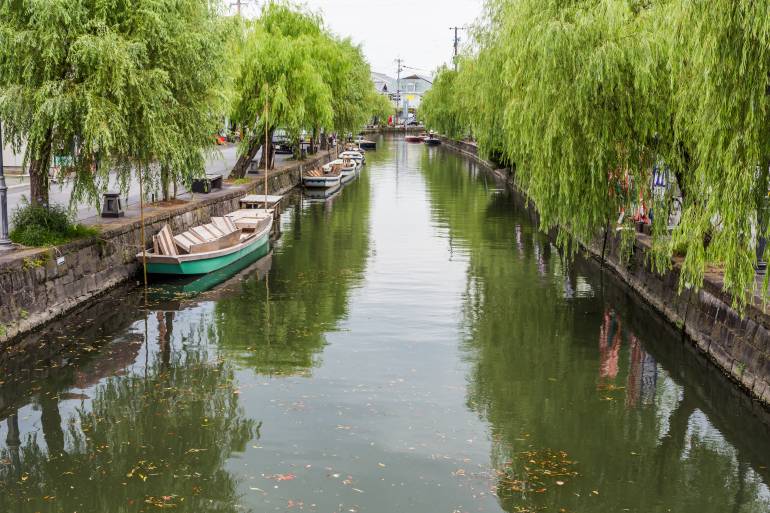
Alternatively, you could visit the joint most important shrine in Japan: the Dazaifu Tenmangu Shrine in the nearby town of Dazaifu. Alongside Kyoto’s Kitano Tenmangu, the shrine is dedicated to the spirit of Sugawara Michizane, a Heian-period politician and scholar who died there in 903. Famed for stunning plum trees and a heart-shaped pond, it’s a pretty good day out, especially with the Kysushu National Museum next door.
A further option for all the cat people out there is to visit Ainoshima Island, one of the famous cat islands of Japan. Catch the train to Nishitetsu-shingu Station and hop onto a community bus for a 100-yen ride to the port (or walk) and get on the ferry which takes 17 minutes and costs 460 yen. Times are limited, so best to aim for 9:20am departure from Shingu and return on the 4pm from Ainoshima. The island has cats, cats and more cats, along with a few small sightseeing spots like the ancient Tumuli and the Hanagurise rock formation.
17:41 start | Train to Tokyo | Change at Shin-Osaka | 6 hours | [22,130 yen]
Whatever you ended up doing with your day, catch the 17:41 from Hakata, change at Shin-Osaka Station, and arrive back in Tokyo at 23:26 – with half an hour to spare on your rail pass. If you have your Tokyo hostel near a JR line station, even better!

